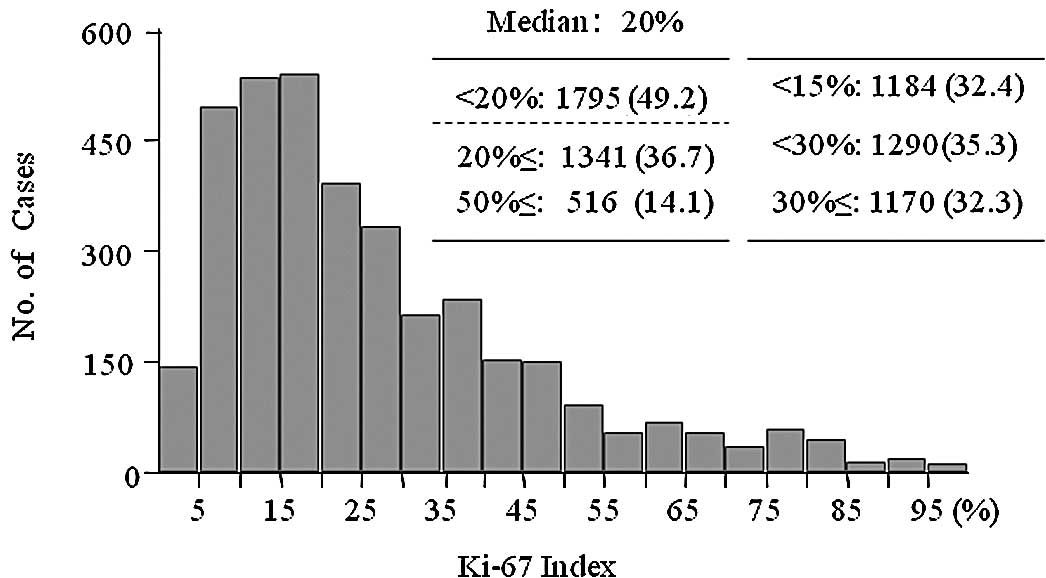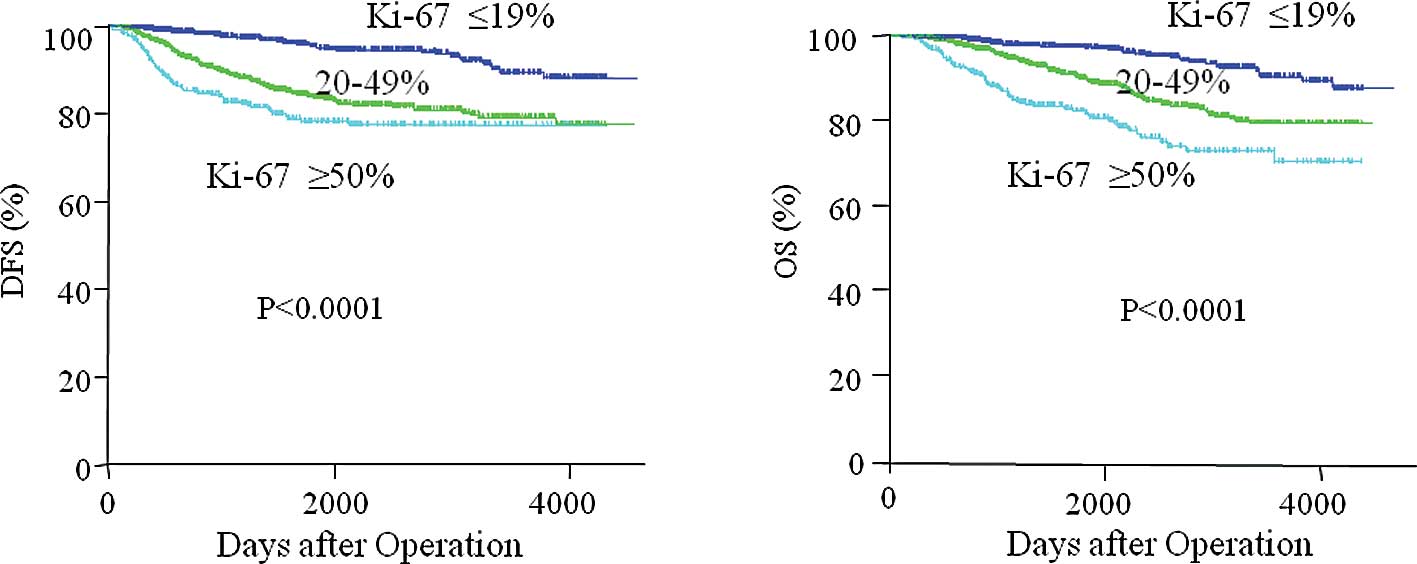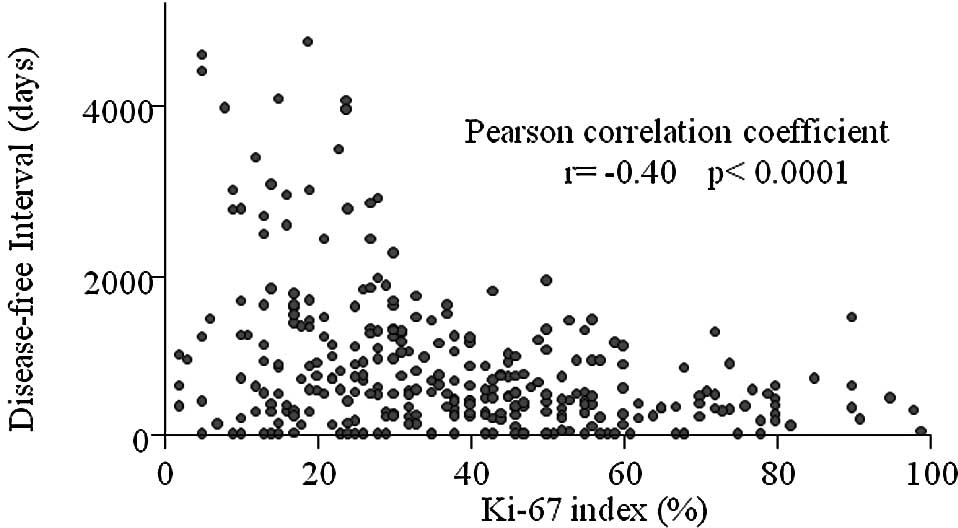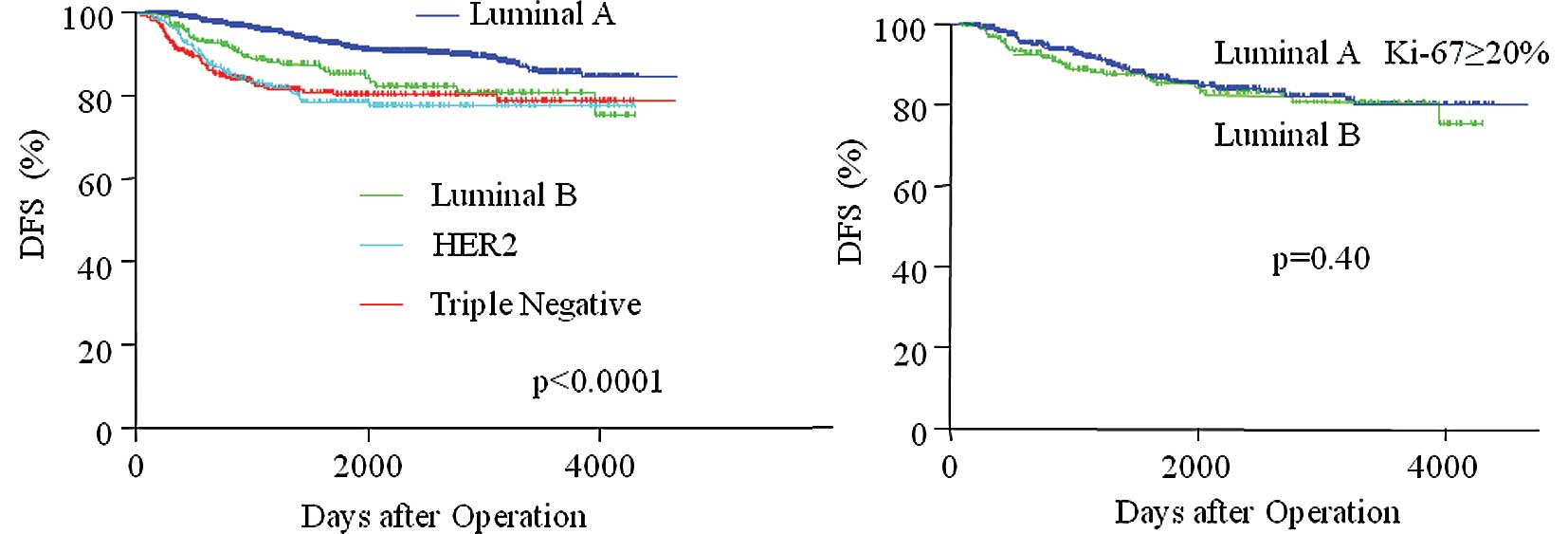Ki-67 as a prognostic marker according to breast cancer subtype and a predictor of recurrence time in primary breast cancer
- Authors:
- Published online on: July 21, 2010 https://doi.org/10.3892/etm.2010.133
- Pages: 747-754
Abstract
Introduction
Recently, research on the biology of breast cancer has made surprising progress. An attempt to understand the unique biological characteristics of individual tumors to facilitate treatment has been realized. At present, treatment strategy is, not only based on the stage classification, but also on tumor biology. The St. Gallen International Expert Consensus on the primary therapy of early breast cancer outlines the guidelines for endocrine and chemotherapy treatment (1). The treatment allocation mainly consists of targeted treatments, such as endocrine therapy for estrogen receptor (ER)-positive tumors and anti-HER2 therapy for HER2-positive tumors. Chemotherapy is recommended for triple negative (TN) tumors that have no targets. At present, the vital problem is how to incorporate chemotherapy into the treatment of hormone-sensitive patients with ER-positive and HER2-negative tumors, as they make up the majority of the patients with primary breast cancer. One solution is to consider the Ki-67 index when deciding the method of treatment.
Ki-67 is present in all proliferating cells, and there is great interest in its role as a proliferation marker (2). The Ki-67 antibody reacts with 395 kDa, which is a nuclear non-histone protein that is present in all active phases of the cell cycle, except the G0 phase (3). Moreover, Ki-67 is one of the 21 prospectively selected genes included in the Oncotype DX™ assay used to predict the risk of recurrence and the extent of chemotherapy benefits in women with node-negative, ER-positive breast cancer (4,5). The proliferation biomarker Ki-67 is considered to be a prognostic factor for breast cancer and has been investigated in several studies (6–8).
In this study, we compared the Ki-67 index with clinicopathological factors in 3,652 cases with early breast cancer as well as with prognosis [disease-free survival (DFS) and overall survival (OS)] according to the breast cancer subtypes, luminal, HER2 and TN, at a single institute.
Patients and methods
Patients
The Ki-67 index was measured in 3,652 cases with primary breast cancer from 1987 to 2009 in Kumamoto City Hospital, Japan. Out of these patients, 2,638 cases were evaluated simultaneously for ER, progesterone receptor (PgR) and HER2 from 1997, and these were analyzed as prognostic factors according to their subtypes. The present study was approved by the ethics committee of Kumamoto City Hospital, and informed consent was obtained from all of the the patients. Table I shows the patient characteristics. The age of the patients ranged from 25 to 95 years (mean 52.2), and the mean tumor diameter was 2.2 cm (range 0.1–22). Two-thirds (65.9%) of the patients had pathologically negative nodes. In terms of the biological markers, the ER- and PgR-positive rates were 74.6 and 61.7%, respectively. HER2 cases of 3+ had a rate of 14.6% and the p53 overexpression rate was 21.3%.
Histopathological examination
The factors investigated included the presence or absence of lymph node metastasis, nuclear grade, ER/PgR status, proliferation (Ki-67), HER2 and p53 overexpression. Immunostaining for ER, PgR, p53, Ki-67 and HER2 was carried out as previously described (9). The positive cell rates for ER/PgR were determined by immunohistochemistry (IHC), and a value of ≥10% was rated as positive. The proliferative activity was determined by immunostaining for the Ki-67 antibody (Dako, Glostrup, Denmark). The fraction of proliferating cells was based on a count of at least 500 tumor cells. The Ki-67 values were expressed as the percentage of positive cells in each case. p53 and HER2 expression was evaluated by immunostaining (LSAB method) with the mouse monoclonal anti-p53 antibody (clone DO7; Dako) and the Hercep Test (Dako). The staining pattern of the p53 protein was divided into three groups: 2+ (homogenous and diffuse staining), 1+ (heterogeneous or focal staining >5% of cancer cells) and negative (focal staining <5% of cancer cells). The staining pattern of HER2 was divided into four groups: 3+ (strong and diffuse staining), 2+ (moderate and diffuse staining), 1+ (focal staining >10% cancer cells) and negative.
Fig. 1 shows the distribution of the Ki-67 index for all of the patients. Many patients had a value of 10–19% on the Ki-67 index in all of the groups, and the median value was 20%. Therefore, the Ki-67 values were divided into 2 or 3 groups; <20% and ≥20% (and ≥50%). One-third of each of the groups was divided according to the St. Gallen Consensus meeting, which recommended a cut-off value of 15 or 30%. The findings of our study revealed the cut-off point as being 20%. Regarding the histological types and Ki-67 index, tumors with DCIS, lobular carcinoma and mucinous carcinoma had lower values on the Ki-67 index; the median values were 13, 14 and 17%, respectively. Most of the cases were invasive ductal carcinomas with a median Ki-67 index of 22% (Table II).
Breast cancer subtype and adjuvant therapy
Breast cancer is classified by gene expression profile into subtypes consisting of two hormone receptor (HR)-positive types (luminal A and B) and three HR-negative types (HER2-expressing, basal-like and unclassified ‘normal-like’). IHC surrogate panels have also been proposed to potentially identify the molecular-based groups. In this study, HR-positive and HER2-negative tumors were classified as luminal A type; HR-positive and HER2-positive tumors (HER2 IHC: 3+ or 2+ and FISH amplification ratio >2.0) as luminal B type; HR-negative and HER2-positive tumors as HER2 disease; and HR-negative and HER2-negative tumors as TN type.
As shown in Table III, the distribution of cases was as follows: luminal A, 1,749 cases (66.3%); luminal B, 263 cases (10%); HER2 disease, 271 cases (10.2%) and TN, 356 cases (13.5%). Regarding adjuvant therapy, most of the cases with luminal type tumors received endocrine therapy. On the other hand, most of the cases with TN and HER2 disease type were treated with chemotherapy. One-fourth of the patients with luminal A tumors received chemotherapy and ∼60% of those with luminal B tumors were treated with chemotherapy. Anti-HER2 therapy with trastuzumab has been used in Japan since receiving approval in 2008.
Statistical analysis
For statistical processing, the Chi-square test and Fisher's exact test were used for inter-group comparison (Tables IV, V and VI). Wilcoxon's (non-parametric) test was used to compare the mean values for tumor size and age. The Kaplan-Meier test was was used to calculate prognosis (cumulative DFS and OS) and tested with the log-rank procedure. Cox's proportional hazard model was used to perform univariate and multivariate analyses of the factors related to DFS. In recurrent cases, the relationship between disease-free interval times and Ki-67 index was analyzed statistically using the Pearson correlation coefficient. The median observation period was 68.5 months.
Results
Ki-67 index and breast cancer subtype(s)
As shown in Table IV, the median Ki-67 index of tumors with luminal A was 17% and that of tumors with luminal B was 29%; the median Ki-67 index for tumors with HER2 was 40% and that for TN tumors was 50%. There was a significant difference among these values. Approximately 60% of the luminal A type tumors had lower proliferation (Ki-67 <20%), while more than half of the TN type tumors had higher proliferation (Ki-67 ≥50%).
Ki-67 index and clinicopathological factors
Table V shows the relationship between the Ki-67 index and the clinicopathological factors in primary breast cancer. A higher Ki-67 index significantly correlated with larger tumors, younger age, positive lymph nodes, a higher nuclear grade, negative ER/PgR, p53 overexpression and positive HER2. Older patients (≥65 years) had tumors with lower proliferation; however, there was no difference in the Ki-67 index values of the tumors in patients between 36–50 and 50–65 years of age.
Ki-67 index and prognosis
Fig. 2 depicts the relationship between the Ki-67 index and prognosis (Fig. 2A, DFS and 2B, OS). Patients with a higher Ki-67 index had significantly lower DFS and OS rates than those with a lower index. Moreover, patients with a Ki-67 index ≥20% had a similar DFS as those with an index of ≥50% 10 years after the operation. This indicates that the dichotomized data (<20 vs. ≥20%) was appropriate for the evaluation of DFS.
Regarding the disease-free interval times in recurrent cases (Fig. 3), these cases were inversely associated with Ki-67 using Pearson correlation coefficient (P<0.0001). Moreover, most of the patients with a Ki-67 index of ≥50% had recurrence within 2 years after the operation. On the other hand, ∼10% of the patients with a Ki-67 index of <20% had recurrences over 10 years. There was a significant difference in the recurrence time after the operation among the Ki-67 index groups (Table VI).
Univariate and multivariate analyses were performed to identify the prognostic factors for DFS (Table VII). The significant factors included tumor size, lymph node status, p53, HER2, hormone dependency and Ki-67 in the univariate analysis. Multivariate analysis revealed that tumor size, lymph node status, Ki-67 index and hormone dependency were significant factors for DFS. When evaluating the significant factors for DFS as a function of lymph node metastasis, tumor size and Ki-67 index were independent factors in both groups. Adjuvant treatments were not significant factors in this series (data not shown).
Table VII.Univariate and multivariate analysis of the factors for disease-free survival according to nodal status in breast cancer. |
Breast cancer subtypes and prognosis
In terms of DFS after operation according to breast cancer subtypes (Fig. 4A and Table VIII), patients with luminal A type tumors had more favorable DFS than patients in the other subtype groups (P<0.0001). There were no significant differences among types luminal B, HER2 and TN.
Table IX shows the multivariate analysis of factors for DFS according to breast cancer subtypes. Tumor size and lymph node status were significant factors in all subtypes. However, Ki-67 index was identified as a significant factor only in luminal A type. As shown in Fig. 4B, there was no difference in DFS between luminal A types with Ki-67 >20% and luminal B types. Thus, the Ki-67 index was a significant prognostic factor only in luminal A type, and Ki-67 may distinguish the patients with poor DFS from luminal A type patients with favorable DFS.
Table IX.Multivariate analysis of the factors for disease-free survival according to breast cancer subtypes. |
Discussion
This study included more than 3,500 cases of breast cancer at a single institute and evaluated the clinical significance of the Ki-67 index as a prognostic marker in relation to breast cancer subtypes. Moreover, the relationships between the Ki-67 index and the clinicopathological factors that reflect prognosis were investigated.
The Ki-67 index ranged widely from 1 to 99%, and most of the tumors of the primary breast cancer patients showed a peak of 10–19% with a median of 20%. Regarding the Ki-67 index and clinicopathological factors, a higher Ki-67 index (≥20%) significantly correlated with a higher grade of malignancy, such as negative ER/PgR, higher grade, p53 overexpression and positive HER2. Wiesner et al (10) reported that a Ki-67 proliferation index ≥20% was found to be associated with all of the prognostic factors that were tested (ER, PgR, HER2 and nuclear grade). They stated that for routine clinical purposes, grading appeared to add only limited information about the prognosis in comparison to Ki-67 expression. These data suggest that patients with a higher Ki-67 index have a poorer prognosis.
The present analysis confirmed that Ki-67 expression is a prognostic factor for both OS and DFS, irrespective of the lymph nodal status. Although many studies have investigated the possible use of Ki-67 as a prognostic marker for breast cancer, the optimal cut-off point and scoring protocol have not yet been standardized. The present data included 3,652 tumors, which showed a median Ki-67 value of 20%. The median Ki-67 values were different among the subtypes; the Ki-67 index of luminal A type tumors was low (17%) and that of TN tumors was high (50%). Therefore, the constant cut-off point is crucial when considering the prognosis for breast cancer patients of all subtypes. Moreover, many studies have adopted a cut-off point of 20% (10–13).
A prognostic significance of the Ki-67 index in each subtype was investigated. The Ki-67 index significantly correlated with DFS only in luminal A type tumors, and a multivariate analysis revealed that the Ki-67 index was a significant factor in this type of tumor. Moreover, approximately 40% of luminal A type tumors had a higher Ki-67 index (≥20%) and showed the same DFS rate as luminal B type tumors. The luminal A type group should be treated more frequently with chemotherapy, as tumors with a higher Ki-67 index frequently respond better to chemotherapy (14–16). Cheang et al (17) suggested that the most appropriate Ki-67 index cut-off point to distinguish luminal B from luminal A tumors was 13.25% in a similar manner using a gene expression profile. Hormone-sensitive breast cancers with higher Ki-67 levels (>13.25%) were assigned to the luminal B group and were associated with a worse prognosis compared to tumors with lower Ki-67 levels (<13.25%). There were 625 luminal A, 263 luminal B and 55 luminal/HER2+ tumors that were node-negative at the time of diagnosis, and these cases were not treated with systemic therapy. This method using Ki-67 may be suitable for the diagnosis and treatment in practical clinical settings.
Regarding Ki-67 as a predictive factor, most of the studies outlining the importance of Ki-67 to predict the clinical and/or pathological response to chemotherapy in early or locally advanced breast cancer, found that a higher Ki-67 was associated with a more favorable response. We previously reported that there was no pathological responder in cases with Ki-67 <25% (16).
Topoisomerase II α (topo IIα) may become a predictive tool with which to identify candidates who may benefit from anthracycline (18). Furthermore, a topo IIα gene amplification is rarely detected in HER2-negative tumors. However, hyperproliferation was found to lead to topo IIα protein over-expression independently of topo IIα gene status (19).
In terms of the efficacy of docetaxel, Penault-Llorca et al (11) reported that a higher Ki-67 (≥20%) was a candidate biomarker for predicting the docetaxel efficacy in ER-positive breast cancer. Notably, the predictors of tumor progression during neoadjuvant chemotherapy included a high Ki-67 score (median score, 60% for progressive disease vs. 30% for response/stable disease) (20). On the other hand, no significant relationship between the Ki-67 score and response to treatment has been reported for neoadjuvant endocrine treatment (21,22). However, Dowsett et al (23) indicated that measurements of Ki-67 level after short-term endocrine treatment may improve the prediction of recurrence-free survival. These findings suggest that the Ki-67 index is an important marker, not only at baseline, but also throughout the course of treatment.
In conclusion, the Ki-67 index had a wide distribution of 1–99% in primary breast cancer, and the median was 20% in 3,652 cases. A higher Ki-67 index (≥20%) correlated significantly with young age, large tumors, positive lymph nodes, negative ER/PgR, p53 overexpression and positive HER2. A higher Ki-67 index correlated with a poorer prognosis and early recurrence (<2 years). On the other hand, a lower Ki-67 index correlated with a favorable prognosis and late recurrence (>10 years). Thus, proliferative activity determined by Ki-67 may reflect the aggressive behavior of breast cancer and predict the time of recurrence and the appropriate therapy. It is therefore important to take the Ki-67 index into consideration in the treatment and follow-up of breast cancer patients.
Acknowledgements
We would like to express our gratitude to the staff at the Department of Clinical Pathology, Kumamoto City Hospital, for the technical assistance and for collecting cancer tissue.
References
|
Goldhirsch A, Ingle JN, Gelber RD, Coates AS, Thürlimann B and Senn HJ: panel members:. Thresholds for therapies: highlights of the St Gallen International Expert Consensus on the primary therapy of early breast cancer 2009. Ann Oncol. 20:1319–1329. 2009. View Article : Google Scholar : PubMed/NCBI | |
|
Gerdes J, Schwab U, Lemke H and Stein H: Production of a mouse monoclonal antibody reactive with a human nuclear antigen associated with cell proliferation. Int J Cancer. 31:13–20. 1983. View Article : Google Scholar : PubMed/NCBI | |
|
Cattoretti G, Becker MH, Key G, Duchrow M, Schlüter C, Galle J and Gerdes J: Monoclonal antibodies against recombinant parts of the Ki-67 antigen (MIB 1 and MIB 3) detect proliferating cells in microwave-processed formalin-fixed paraffin sections. J Pathol. 168:357–363. 1982. View Article : Google Scholar | |
|
Paik S, Shak S, Tang G, et al: A multigene assay to predict recurrence of tamoxifen-treated, node-negative breast cancer. N Engl J Med. 351:2817–2826. 2004. View Article : Google Scholar : PubMed/NCBI | |
|
Paik S, Tang G, Shak S, et al: Gene expression and benefit of chemotherapy in women with node-negative, estrogen receptor-positive breast cancer. J Clin Oncol. 24:3726–3734. 2004. View Article : Google Scholar : PubMed/NCBI | |
|
De Azambuja E, Cardoso F, de Castro G Jr, et al: Ki-67 as prognostic marker in early breast cancer: a meta-analysis of published studies involving 12,155 patients. Br J Cancer. 96:1504–1513. 2007.PubMed/NCBI | |
|
Yerushalmi R, Woods R, Ravdin PM, Hayes MM and Gelmon KA: Ki67 in breast cancer: prognostic and predictive potential. Lancet Oncol. 11:174–183. 2010. View Article : Google Scholar : PubMed/NCBI | |
|
Urruticoechea A, Smith IE and Dowsett M: Proliferation marker Ki-67 in early breast cancer. J Clin Oncol. 23:7212–7220. 2005. View Article : Google Scholar : PubMed/NCBI | |
|
Kai K, Nishimura R, Arima N, Miyayama H and Iwase H: p53 expression status is a significant molecular marker in predicting the time to endocrine therapy failure in recurrent breast cancer: a cohort study. Int J Clin Oncol. 11:426–433. 2006. View Article : Google Scholar : PubMed/NCBI | |
|
Wiesner FG, Magener A, Fasching PA, et al: Ki-67 as a prognostic molecular marker in routine clinical use in breast cancer patients. Breast. 18:135–141. 2009. View Article : Google Scholar : PubMed/NCBI | |
|
Penault-Llorca F, Andre F, Sagan C, et al: Ki67 expression and docetaxel efficacy in patients with estrogen receptor-positive breast cancer. J Clin Oncol. 27:2809–2815. 2009. View Article : Google Scholar : PubMed/NCBI | |
|
Clahsen PC, van de Velde CJ, Duval C, et al: The utility of mitotic index, estrogen receptor and Ki-67 measurements in the creation of novel prognostic indices for node-negative breast cancer. Eur J Surg Oncol. 25:356–363. 1999. View Article : Google Scholar : PubMed/NCBI | |
|
Weikel W, Brumm C, Wilkens C, Beck T and Knapstein PG: Growth fractions (Ki-67) in primary breast cancers, with particular reference to node-negative tumors. Cancer Detect Prev. 19:446–450. 1995.PubMed/NCBI | |
|
Petit T, Wilt M, Velten M, et al: Comparative value of tumour grade, hormonal receptors, Ki-67, HER2 and topoisomerase II alpha status as predictive markers in breast cancer patients treated with neoadjuvant anthracycline based chemotherapy. Eur J Cancer. 40:205–211. 2004. View Article : Google Scholar | |
|
Mauriac L, MacGrogan G, Avril A, et al: Neoadjuvant chemotherapy for operable breast carcinoma larger than 3 cm: a unicentre randomized trial with a 124-month median follow-up. Institut Bergonie Bordeaux Groupe Sein (IBBGS). Ann Oncol. 10:47–52. 1999. View Article : Google Scholar | |
|
Nishimura R, Osako T, Okumura Y, Hayashi M and Arima N: Clinical significance of Ki-67 in neoadjuvant chemotherapy for primary breast cancer as a predictor for chemosensitivity and for prognosis. Breast Cancer. Sept. 4–2009.(E-pub ahead of print). | |
|
Cheang MCU, Chia SK, Voduc D, et al: Ki67 index, HER2 status, and prognosis of patients with luminal B breast cancer. J Natl Cancer Inst. 101:736–750. 2009. View Article : Google Scholar | |
|
Di Leo A, Biganzoli L, Claudino W, Licitra S, Pestrin M and Larsimont D: Topoisomerase II alpha as a marker predicting anthracyclines' activity in early breast cancer patients: ready for the primetime? Eur J Cancer. 44:2791–2798. 2008. | |
|
Durbecq V, Desmed C, Paesmans M, et al: Correlation between topoisomerase-II alpha gene amplification and protein expression in HER-2 amplified breast cancer. Int J Oncol. 25:1473–1479. 2004.PubMed/NCBI | |
|
Caudle AS, Gonzalez-Angulo AM, Hunt KK, et al: Predictors of tumor progression during neoadjuvant chemotherapy in breast cancer. J Clin Oncol. 28:1821–1828. 2010. View Article : Google Scholar : PubMed/NCBI | |
|
Chang J, Powles TJ, Allred DC, et al: Prediction of clinical outcome from primary tamoxifen by expression of biologic markers in breast cancer patients. Clin Cancer Res. 6:616–621. 2000.PubMed/NCBI | |
|
Makris A, Powles TJ, Allred DC, et al: Changes in hormone receptors and proliferation markers in tamoxifen treated breast cancer patients and the relationship with response. Breast Cancer Res Treat. 48:11–20. 1998. View Article : Google Scholar : PubMed/NCBI | |
|
Dowsett M, Smith IE, Ebbs SR, Dixon JM, Skene A, A'Hern R, Salter J, Detre S, Hills M and Walsh G; IMPACT Trialists Group: Prognostic value of Ki67 expression after short-term presurgical endocrine therapy for primary breast cancer. J Natl Cancer Inst. 99:167–170. 2007. View Article : Google Scholar |














